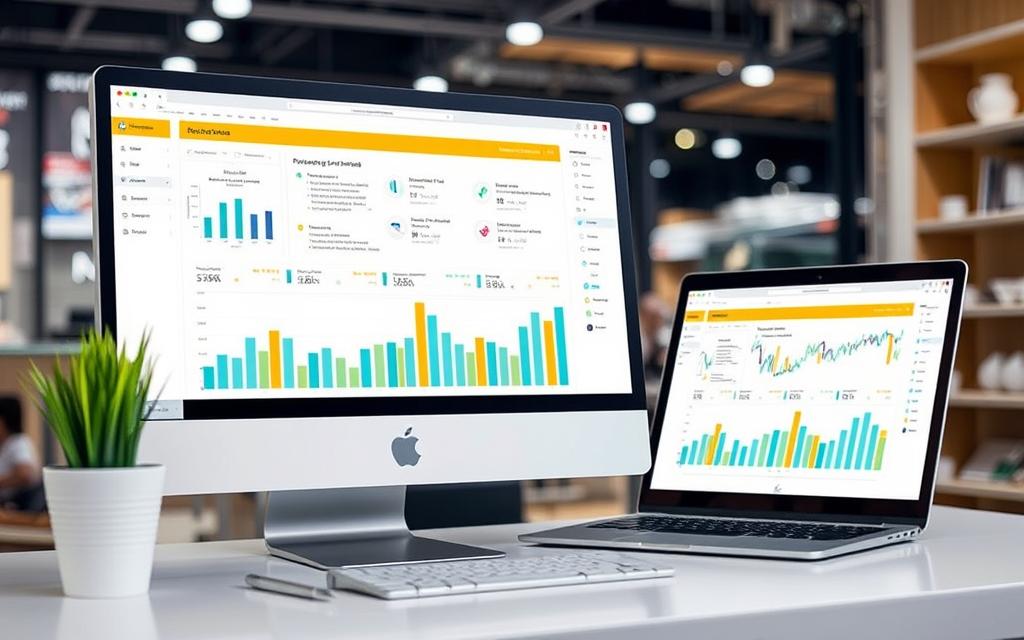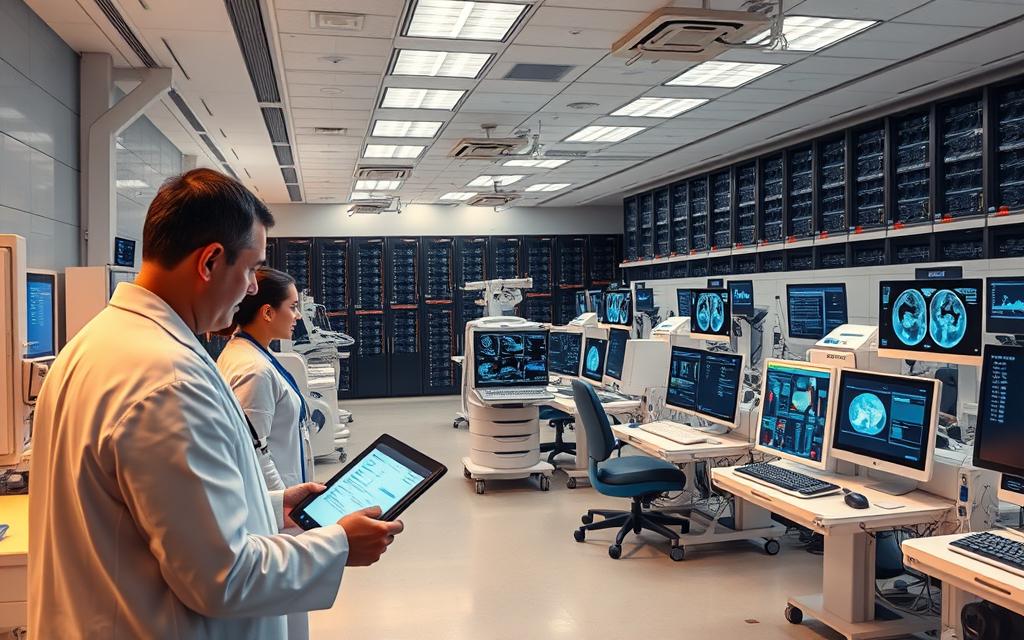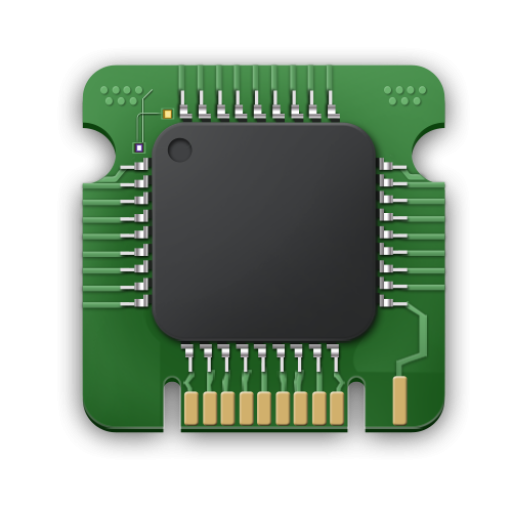Information technology (IT) has become the backbone of modern society, transforming how we live, work, and communicate. IT encompasses a broad range of functions, including building communications networks, safeguarding data, and troubleshooting computer problems.
This comprehensive guide will explore the vast and complex world of IT, breaking down key concepts into accessible information. As we navigate today’s technology-driven landscape, understanding the fundamentals of information technology is essential for personal knowledge and professional development.
The importance of IT in the workplace cannot be overstated, from checking email on our phones to organizing teleconferences over cloud-based software. As the world becomes increasingly reliant on technology, addressing common questions about IT and its applications is crucial.
Understanding Information Technology
The concept of information technology has been around since the 1950s, with its definition and scope evolving over time. The phrase “information technology” was first used in a 1958 Harvard Business Review article by Harold J. Leavitt and Thomas L. Whisler, who defined it through several key aspects.
Definition and Scope of IT
Information technology refers to the use of computer systems and digital tools to access, manage, and process information. The scope of IT is broad, encompassing not just computers, but also networks, software applications, data management systems, and various digital technologies that facilitate information processing. Key aspects of IT include:
- Combining technology and data to support business operations and personal tasks.
- Encompassing a wide range of specializations, including software development, network administration, cybersecurity, data analytics, and systems management.
The Evolution of Information Technology
IT has evolved significantly from room-sized computers with limited capabilities to sophisticated systems that can process vast amounts of data in milliseconds. This evolution has transformed how we interact with information, making it a critical component of modern life. The field of IT continues to expand, driving innovation and supporting various industries.
The Historical Journey of Information Technology
The journey of information technology began with early mechanical devices, laying the foundation for the sophisticated systems we use today. The history of technology is marked by significant milestones that have transformed the way we process information and interact with computers.

Early Computing Milestones
The first mechanical computer device, the Difference Engine, was conceptualized by Charles Babbage in the early 19th century to aid in navigational calculations. This innovation marked the beginning of a new era in computing. Other notable milestones include the development of Colossus, recognized as the world’s first programmable electronic digital computers, between 1943-1945.
The Birth of Modern Computing
The birth of modern computing can be attributed to the development of the first commercial computers like UNIVAC I and IBM701 in the 1950s. These systems revolutionized data processing for businesses and government agencies, significantly enhancing their capabilities. The introduction of these commercial computers marked a pivotal point in the growth of information technology.
The Digital Revolution
The digital revolution gained momentum in the 1970s and 1980s with the introduction of personal computers, making technology accessible to individuals for the first time. This period saw an exponential growth in information technology driven by innovations like integrated circuits and microprocessors, which dramatically reduced the size of computers while increasing their processing power over time.
- The journey began with early mechanical calculating devices like the abacus and evolved through Charles Babbage’s Difference Engine.
- The mid-20th century saw the development of the first programmable electronic digital computers, such as Colossus.
- The first commercial computers, like UNIVAC I and IBM701, transformed data processing capabilities.
- The digital revolution made computing technology accessible to individuals with the introduction of personal computers.
- Innovations like integrated circuits and microprocessors drove the exponential growth of information technology.
What Do You Know About Information Technology Components?
The foundation of information technology lies in its diverse components, which include hardware, software, and networking infrastructure. These elements work together to enable efficient data processing, storage, and communication.
Hardware Elements
Hardware elements form the physical foundation of IT systems. They include devices such as computers, servers, storage devices, input/output peripherals, and mobile devices. Modern computers are significantly better than their predecessors in terms of size, weight, mobility, input and output capabilities, capacity, and functionality. The first personal computers were made of heavy metals and dense plastics, making them susceptible to damage and difficult to transport. Today, computing devices are designed with lightweight and sturdier materials, enhancing their portability.
Software Systems
Software systems encompass operating systems, applications, databases, and programming tools that enable computers to perform specific functions and process data. Modern software has become more sophisticated, user-friendly, and capable of handling complex tasks. The evolution of software has significantly improved the efficiency and productivity of IT systems.
Networks and Communication Infrastructure
Networks and communication infrastructure connect devices and systems, allowing for data exchange and resource sharing through technologies like LANs, WANs, the Internet, and wireless networks. This infrastructure is crucial for facilitating communication and data transfer between different locations and devices, thereby supporting the overall functionality of IT systems.
Types of Information Technology
The field of Information Technology is multifaceted, comprising several key areas that are crucial for modern businesses and organizations.
Data Analytics and Business Intelligence
Data Analytics and Business Intelligence technologies enable organizations to collect, process, and analyze large volumes of data to identify patterns, trends, and insights that inform strategic decision-making.

Cloud Computing Technologies
Cloud Computing Technologies provide on-demand access to computing resources, including servers, storage, databases, and software, delivered over the internet with minimal management effort.

Cybersecurity Systems
Cybersecurity Systems protect information technology infrastructure, networks, and data from unauthorized access, attacks, and damage through various security measures, protocols, and software solutions.

Automation and AI Technologies
Automation and AI Technologies leverage artificial intelligence, machine learning, and robotic process automation to perform tasks that traditionally required human intervention, increasing efficiency and reducing errors.

These diverse types of information technology often work together in integrated systems, with cloud computing providing the infrastructure, data analytics generating insights, cybersecurity ensuring protection, and automation streamlining processes.
Core IT Services in Modern Organizations
Modern organizations rely heavily on various IT services to maintain their operational efficiency. These services encompass a range of critical tasks and functions that ensure the smooth operation of systems and technology within the organization.
Hardware and Software Support
Hardware and software support services are crucial for maintaining an organization’s technological infrastructure. These services include installation, maintenance, troubleshooting, and upgrading of physical equipment and software applications, ensuring that all technology is functioning properly.
Network Management
Network management involves designing, implementing, and maintaining the communication infrastructure that connects systems and devices. This includes managing networks, routers, switches, and firewalls to ensure secure and efficient data transmission throughout the organization.

Data Management and Storage
Data management and storage services handle the organization’s information assets, including database administration, data warehousing, backup solutions, and disaster recovery planning. Effective management of data ensures information quality and regulatory compliance.
| Service | Description |
|---|---|
| Hardware and Software Support | Maintenance and troubleshooting of hardware and software |
| Network Management | Designing and maintaining network infrastructure |
| Data Management and Storage | Handling data assets and ensuring data quality |
| Help Desk and Technical Support | Assistance for users experiencing technical issues |
Help Desk and Technical Support
Help desk and technical support functions provide assistance to users experiencing technical issues. IT professionals offer troubleshooting, problem resolution, and guidance on effectively utilizing IT resources, ensuring minimal disruption to the organization’s operations.
These core IT services are delivered by teams of IT professionals who work collaboratively to maintain system functionality, optimize performance, and support the organization’s operational needs. For more information on IT, visit https://www.techtarget.com/searchdatacenter/definition/IT.
The Impact of Information Technology on Business
The impact of information technology on business is multifaceted, transforming how companies operate and compete. By leveraging technology, businesses can enhance their operational efficiency, improve communication, and make data-driven decisions.
Enhancing Communication and Collaboration
Information technology has revolutionized business communication and collaboration by enabling instant messaging, video conferencing, and document sharing. This allows teams to work together seamlessly, regardless of their physical location, thereby improving overall productivity.
Improving Efficiency and Productivity
IT systems have dramatically improved efficiency and productivity by automating routine tasks and streamlining workflows. By utilizing faster hardware and digital tools, businesses can accomplish more in less time, saving both time and resources.
Supporting Strategic Decision-Making
Data analytics and business intelligence tools have enhanced strategic decision-making in businesses. By transforming raw data into actionable insights, these tools support evidence-based management approaches, enabling businesses to make informed decisions.

By integrating these technological advancements, businesses can create a more flexible and efficient work environment. This not only drives innovation but also enables companies to develop new products, services, and business models that would not be possible without advanced technological capabilities.
Information Technology in Various Industries
The integration of information technology into various industries has revolutionized traditional practices and opened up new opportunities. As a result, businesses across different sectors are leveraging IT to enhance their operations and improve customer experiences.
IT in Healthcare
Healthcare has seen significant advancements with the adoption of information technology, including Electronic Health Records (EHRs), telemedicine, and data analytics. These technologies improve patient care, diagnosis, and research, enhancing the overall efficiency of the healthcare system. 
IT in Finance and Banking
The finance and banking industries rely heavily on IT for secure transaction processing, fraud detection, algorithmic trading, and customer relationship management. These technologies ensure the integrity and efficiency of financial operations.
IT in Education
Education has been transformed by information technology through learning management systems, digital textbooks, online courses, and educational applications. These tools make learning more accessible and personalized, enhancing educational opportunities for students.
IT in Manufacturing and Retail
Manufacturing and retail businesses leverage IT for supply chain management, inventory control, automated production systems, and e-commerce platforms. These technologies optimize operations and enhance customer experiences, driving business growth.
Across all industries, information technology services have become essential for maintaining a competitive advantage. Companies are investing in specialized IT solutions tailored to their specific fields and business needs, underscoring the critical role of IT in modern business.
The Role of IT in Digital Transformation
Information technology plays a crucial role in digital transformation, enabling businesses to adapt to changing market demands. The integration of digital technology into all areas of operation is fundamentally changing how businesses operate and deliver value to customers.
Enabling Remote Work and Flexibility
IT infrastructure, cloud computing platforms, and communication tools have significantly enhanced remote work capabilities, allowing employees to work effectively from any location. This flexibility attracts top talent and reduces travel costs.
Driving Innovation and New Business Models
Information technology enables innovation by providing the necessary tools and platforms for developing new products, services, and business models that respond to changing market demands and consumer preferences. This drives business growth and competitiveness.
Creating Competitive Advantages
Organizations that effectively leverage IT in their digital transformation efforts gain competitive advantages through improved operational efficiency, enhanced customer experiences, and data-driven decision-making capabilities.
Information Technology Career Paths
The IT industry encompasses a broad spectrum of career options, from technical support to leadership positions. With the rapid evolution of technology, the demand for skilled IT professionals continues to grow, offering a wide range of opportunities for individuals with diverse skills and interests.
Entry-Level IT Positions
Entry-level IT positions such as help desk technician, technical support specialist, and junior programmer provide foundational experience in the field and often require basic certifications or associate degrees in computer-related disciplines.
Specialized IT Roles
Specialized IT roles include network administrators, database administrators, software developers, cybersecurity analysts, and cloud computing specialists, each requiring specific technical skills and knowledge in their respective fields.
IT Management and Leadership
IT management and leadership positions such as IT project managers, IT directors, and Chief Information Officers (CIOs) combine technical expertise with business acumen and people management skills to guide technology strategy and implementation within a team.
Required Skills and Qualifications
The required skills and qualifications for information technology careers vary widely but typically include technical proficiency with relevant software and systems, problem-solving abilities, communication skills, and continuous learning aptitude to support the evolving tech landscape.
Career advancement in the information technology field often involves a combination of formal education, professional certifications, hands-on experience, and the ability to adapt to rapidly evolving technologies and industry trends.
Challenges and Risks in Information Technology
Information technology, while transformative, also introduces significant challenges and risks that organizations cannot afford to overlook. The three major types of IT risks are Cybersecurity Risks, Operational Risks, and Compliance Risks. Managing these risks is essential for protecting data and ensuring business continuity.
Cybersecurity Threats
Cybersecurity threats represent one of the most significant challenges in information technology, with organizations facing increasingly sophisticated attacks. These include malware, ransomware, phishing, and data breaches that can compromise sensitive information.
Operational and Technical Risks
Operational and technical risks encompass system failures, data loss, hardware malfunctions, software bugs, and integration issues. These risks can disrupt business operations and impact service delivery to users.
Compliance and Regulatory Challenges
Compliance and regulatory challenges have grown more complex as governments worldwide implement data protection laws, industry-specific regulations, and security standards. Organizations must navigate these to avoid penalties and maintain trust.
| Risk Type | Description | Impact |
|---|---|---|
| Cybersecurity Risks | Threats like hacking and malware | Data breaches, financial loss |
| Operational Risks | System failures, data loss, human errors | Disrupted business operations |
| Compliance Risks | Violations of industry regulations or legal requirements | Penalties, loss of trust |
Effective risk management in information technology requires a comprehensive approach that includes regular security assessments, robust backup systems, incident response planning, user education, and governance frameworks aligned with business objectives.

Emerging Trends in Information Technology
Emerging trends in information technology are transforming the way businesses operate and people live. The rapid evolution of technology is driving innovation and creating new opportunities.
Artificial Intelligence and Machine Learning
Artificial Intelligence (AI) and Machine Learning (ML) are revolutionizing information technology by enabling systems to learn from data, recognize patterns, and make decisions with minimal human intervention. For businesses looking to leverage AI, AI solutions can be transformative.

Internet of Things (IoT)
The Internet of Things (IoT) connects billions of physical devices to the internet, creating vast networks of smart devices that collect and share data. This enables new applications in home automation, industrial monitoring, and smart cities.
Edge Computing
Edge computing moves data processing closer to the source of data generation, reducing latency and conserving bandwidth. This enables real-time applications for connected devices.
Quantum Computing
Quantum computing represents a paradigm shift in computing technology, using quantum bits to perform calculations exponentially faster than traditional computers for specific problems. Potential applications include cryptography, drug discovery, and complex system modeling.
These emerging technologies are converging to create new possibilities in information technology, with AI enhancing IoT devices, edge computing supporting distributed AI applications, and cloud computing providing the scalable infrastructure needed to manage and analyze the resulting data.
How to Stay Current with IT Developments
The rapidly evolving landscape of IT demands continuous learning and adaptation. To remain relevant, IT professionals must engage in ongoing education and stay informed about the latest developments.
Continuous Learning Resources
Continuous learning resources such as online courses, certifications, webinars, and tutorials provide structured education opportunities for IT professionals to develop new skills and stay current with evolving technologies and tools.
Professional Networks and Communities
Professional networks and communities, including industry associations, forums, social media groups, and local meetups, offer valuable opportunities for knowledge sharing, mentorship, and collaboration with peers in the information technology field.
Technology News and Publications
Technology news sources, blogs, podcasts, and publications deliver timely updates on emerging trends, best practices, and innovative tools, helping professionals stay informed about developments relevant to their areas of expertise and experience.
As Spratling said, “Training, networking with people, getting your name out there is huge.” This emphasizes the importance of learning, education, and staying connected within the industry for effective management of one’s career and staying abreast of information and technology advancements.
Conclusion
As we navigate the complexities of the digital age, it’s clear that information technology plays a pivotal role in shaping our world. The field has evolved significantly, transforming how we communicate, work, and interact with our environment. The continuous growth and innovation in tech create both challenges and opportunities, requiring individuals and organizations to adapt and evolve.
The boundaries between different tech disciplines are increasingly blurring, with integration across artificial intelligence, biotechnology, and quantum computing creating new possibilities. As we look to the future, the growth of information technology shows no signs of slowing down. The world is becoming more interconnected, and understanding technology is crucial for success.
In conclusion, developing a foundational knowledge of information technology is an investment that will yield returns in our increasingly tech-driven society. As new technology emerges and existing ones mature, the questions about its impact will continue to evolve, making continuous learning essential for growth in this dynamic world.







